A theoretical and practical guide: updated to iOS 13 and WatchOS 6
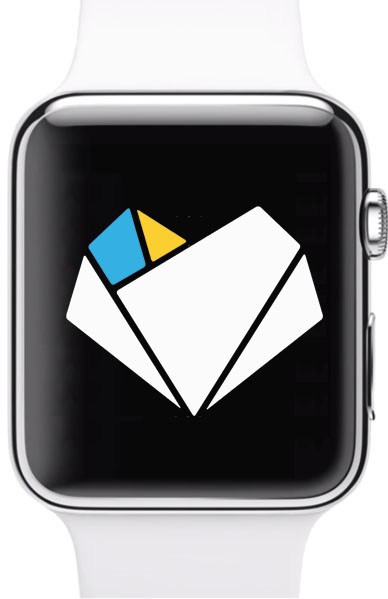
In a previous post, I?ve covered a few of the limitations of the Apple Watch in the context of HRV analysis.
With iOS 13 and Watch OS 6, some of the limitations present when using an Apple Watch for HRV analysis are gone (most importantly SDNN is no longer the only available feature and RR intervals can be accessed via Health).
Thus, you can make better use of the Watch data for your own analysis of physiological stress in response to training and lifestyle stressors.
Yet, a few important aspects need to be considered, for example:
- Context: measurements are often taken automatically at random times in the day or night, which provides meaningless data (as anyone that looked at their HRV data in Health as figured out already). Why is that? The autonomic nervous system (and therefore HRV) is affected by so many things that the only meaningful way to collect data actually representative of physiological stress is by measuring first thing in the morning or during the night (in a so-called reproducible context).
- Practically speaking, how do we take a measurement? The watch does not implement standard protocols and therefore cannot be linked to an app the way you?d link any other sensor. Below we?ll see how you can use a simple workaround to trigger a measurement systematically from the Watch, and read the data back in HRV4Training.
What?s new then?
The main change is the availability of RR intervals in the Health app. This means that we are not forced to rely on SDNN as the only feature available, but we can compute rMSSD (a better marker of parasympathetic activity, more on this later) and also analyze signal quality.
How good is the data?
Recently, researchers at the University of Zaragoza in Spain, published a paper showing that RR intervals extracted from the Apple Watch while using the Breathe app, are indeed very accurate (Hernando et al., ?Validation of the Apple Watch for Heart Rate Variability Measurements during Relax and Mental Stress in Healthy Subjects?). This is great news as it shows that the basic unit of information (RR intervals) can be trusted.
Using the latest iOS and Watch OS version, we could replicate part of the analysis, reading RR intervals from Health and comparing them to what we recorded using Polar straps. For more details on this analysis, you can refer to this blog post.
During data acquisition, we collected data a few minutes while breathing freely, and a few minutes while deep breathing, to elicitate higher HRV due to RSA. You can see in the plots below visually the effect of deep breathing as we get greater swings in RR intervals:
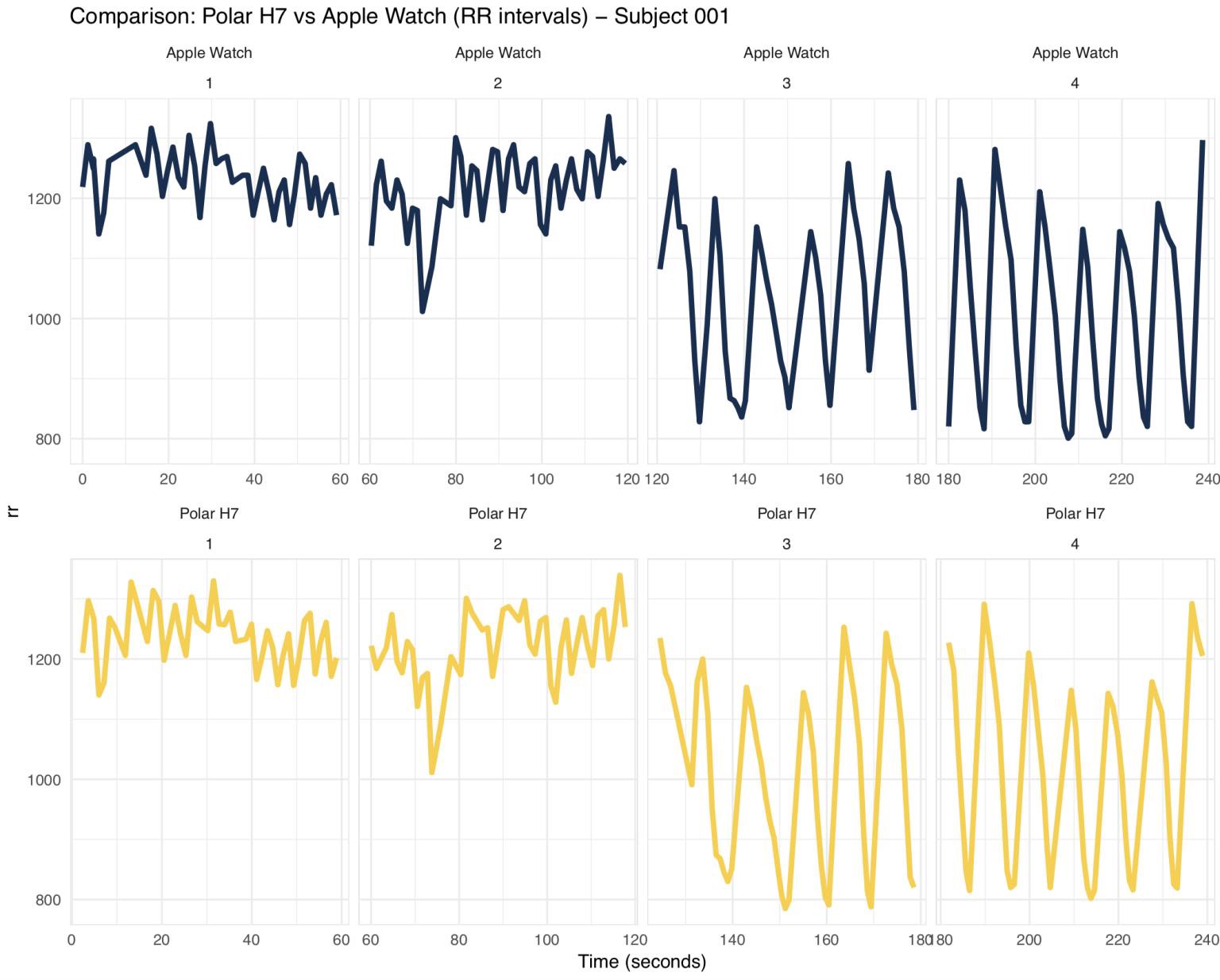
What can we derive from these data? You can see clearly an almost perfect correlation between Polar H7 and Apple Watch for all conditions (relaxed vs paced breathing as highlighted by bigger oscillations in RR intervals or instantaneous heart rate), meaning that the Apple Watch works really well in this modality.
Heart Rate Variability: rMSSD
?As features, we will look at rMSSD. rMSSD is a clear marker of parasympathetic activity and the main feature we use for our analysis in HRV4Training, similarly to what other apps do as well. The sports science community seems to have settled on this feature for several reasons. First, because of the clear physiological link, as mathematically rMSSD captures fast changes that are due to how the vagus nerve modulates heart rhythm, and secondly for practical reasons, as it is easy to acquire, easy to compute and reliable over short time windows and less controlled conditions.
You can find a few examples of how rMSSD changes in response to various stressors (training, traveling, alcohol intake, getting sick, positive or negative adaptations to training, etc.), in this deck. This is an effective way to capture how stress affects your body and how long it takes to get back to homeostasis.
What we expect given the data above is to see extremely close values between the Polar H7 chest strap and Apple Watch data. For the plot below, I computed rMSSD for each time window:
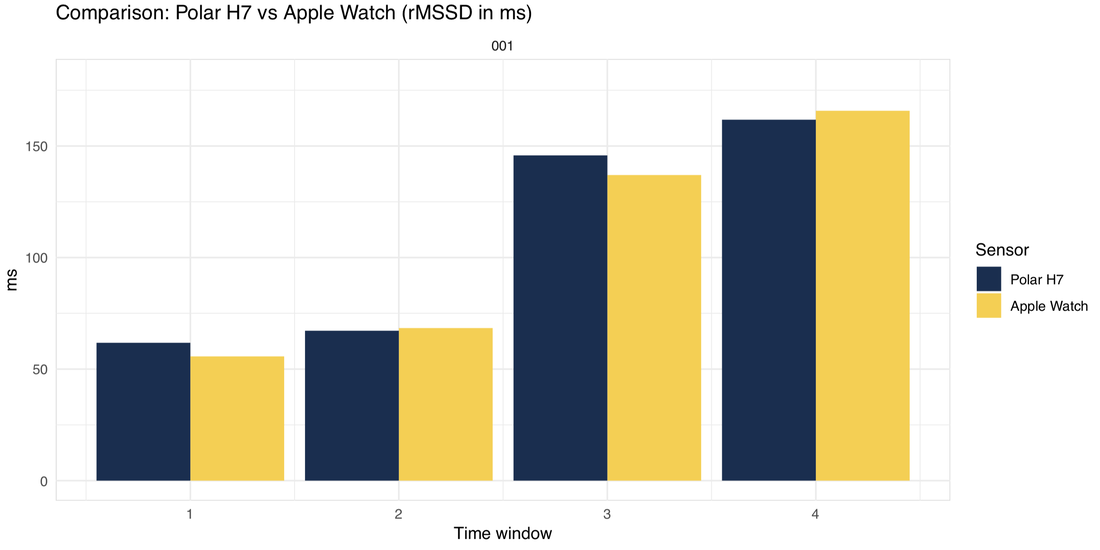
Results are very good considering normal variation in physiology and limitations in data synchronization.
It?s all about context
To me, the main challenge for today?s practitioners is not using one feature or the other, or one sensor or the other, but proper testing. What I mean is that educating people on the importance of context and the morning routine is by far more important than using one tool or feature over the other. Unfortunately, devices that claim to do HRV all day, often simply reporting random data points, are really making it harder to properly communicate these aspects, and this brings me to the final and most important point: reproducible context.
Measuring at the right time
Consider that what we try to measure is parasympathetic activity, so the branch of the autonomic nervous system (ANS) in charge of rest, recovery and relaxation. The ANS is affected by pretty much anything (food, alcohol, coffee, stress ? just think about reading something online and getting some emotional reaction in no time), hence measuring throughout the day typically results in capturing transient stressors and telling us very little about our chronic physiological state.
Even when beat to beat data can be acquired with high accuracy in free living, one single measurement in a well known context (first thing in the morning) is more valuable than recording more data at random times during the day or continuously.
If you are interested in measuring underlying or chronic physiological stress to potentially make adjustments to your lifestyle or training plan, then you would end up missing that information or confounding it with whatever is happening in your day. HRV is highly influenced by acute stressors (because your autonomic nervous system is!), hence the importance of the ?morning routine?, measuring as soon as you wake up.
Despite the fact that no third-party app can control the Apple Watch or take an HRV reading, the Breathe app that comes with the Watch, consistently pushes HRV data to Health every time you use it. Hence, you can, as a matter of fact, trigger an HRV reading using the Breathe app first thing in the morning, and disregard the rest of the data that is automatically collected.
Interpreting your daily measurements
Once you?ve collected your daily measurements for a while, there is something more to discuss: interpreting them.
HRV analysis requires a mindset shift. First of all, we need to understand the nature of the data and the constant re-adjusting of the autonomous nervous system, and therefore take all the necessary steps to acquire a reliable measurement. As we just said, this is typically addressed by the morning routine: the importance of context, limiting external factors, measuring as soon as you wake up and in the same body position every day.
Secondly, we need to shift from a ?higher is better? to a ?normal is better? mentality, as physiologically speaking, being in a stable condition is typically a good sign. The inherent variability of HRV measurements is something that your app or software of choice, needs to deal with. This is something we have spent a lot of time researching and designing in HRV4Training, starting with the way the daily advice is built (more on this later).
An app or software that interprets any HRV increase as a good sign, or any HRV decrease as a bad sign, is failing to correctly represent the fact that there are normal variations in physiology, and that only variations outside of this normal range, should trigger concern or more attention or simply be interpreted as actual changes. This is why normally we build what we call ?your normal values? based on a month or two of historical data, so that we can compare daily measurements or your weekly baseline to your normal values, to determine when you are consistently more stressed than normal (that?s probably a good time to implement some changes!).
Since a picture is worth a thousand words:
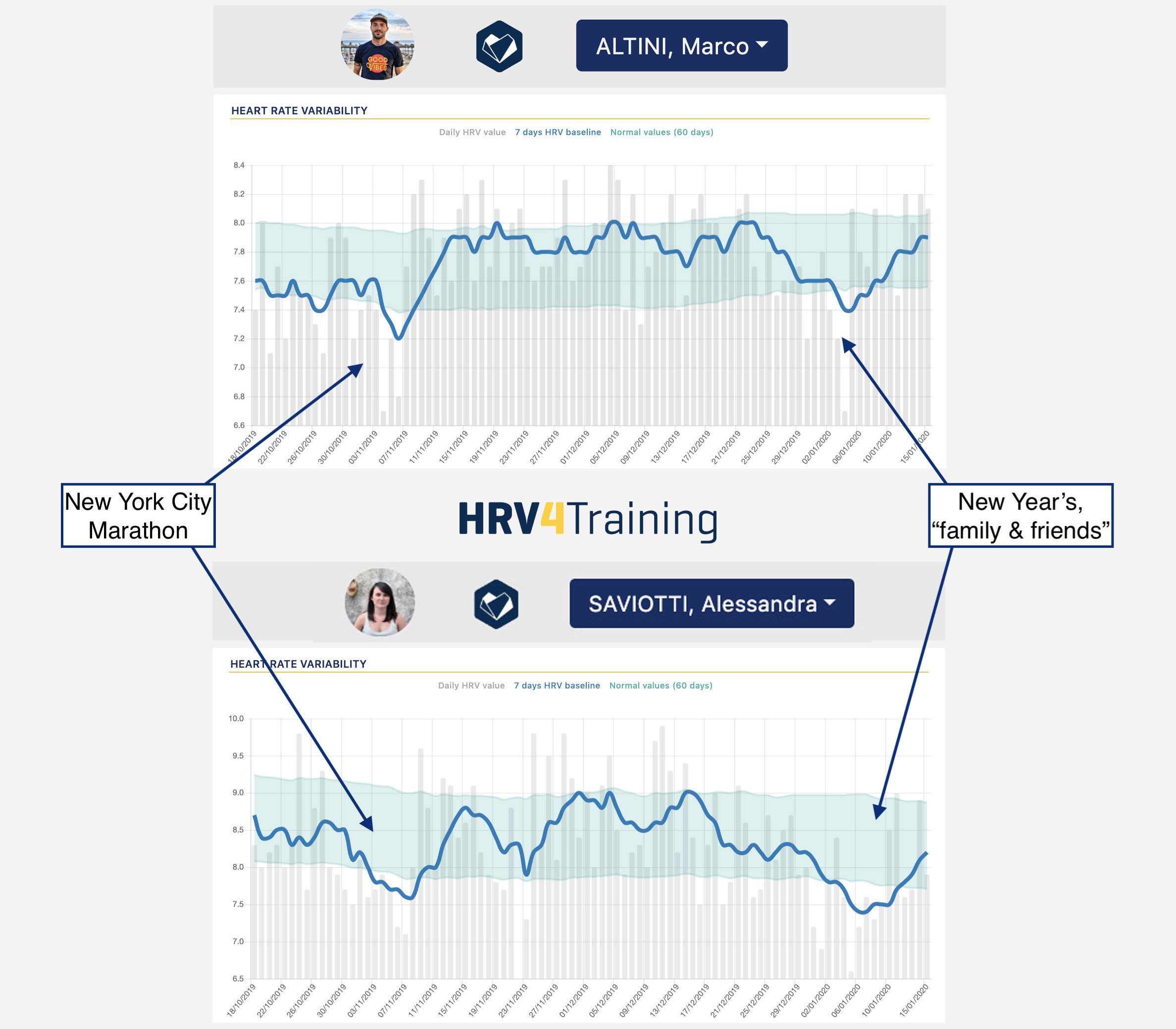 Nothing says true love like matching physiology.
Nothing says true love like matching physiology.
If you are interested in learning more about how to interpret your daily scores, check out out the Ultimate Guide to Heart Rate Variability, parts 1 and 2:
The Ultimate Guide to Heart Rate Variability (HRV): Part 1
Measurement setup, best practices, and metrics.
medium.com
The Ultimate Guide to Heart Rate Variability (HRV): Part 2
You measured, now what?
medium.com
Getting practical: what do you need?
That was a lot of explaining. We?ve assessed that the Apple Watch can record high-quality data, the RR intervals are accurate and can be used to compute rMSSD reliably(our marker of physiological stress) and finally, we have also seen that we can trigger a measurement first thing in the morning using the Breathe app. Wonderful.
Here is a brief overview of how to use HRV4Training with the Watch:
- Select Health as data source under Menu / Settings in the HRV4Training app, then authorize HRV4Training to read HRV data and RR intervals from Health, when automatically prompted
- When you wake up, take a measurement using the Breathe app on your Apple Watch
- Right after, open the HRV4Training app on your phone, tap ?Read from Health? from the main screen, and that?s it. We?ll be doing the math and prompting you with the usual Tags to fill in, so that you can add context around your measurements.
 Set default mode to Health instead of using the Camera or Bluetooth sensors, allow HRV4Training to read from Health, and you are good to go. In the morning, measurements will be taken using the Breathe app, which pushes RR intervals to Health, then you can read the data from HRV4Training, which will interpret it in the context of your historical data.
Set default mode to Health instead of using the Camera or Bluetooth sensors, allow HRV4Training to read from Health, and you are good to go. In the morning, measurements will be taken using the Breathe app, which pushes RR intervals to Health, then you can read the data from HRV4Training, which will interpret it in the context of your historical data.
The last thing that remains to be done is to correctly interpret that morning measurement.
What we do in the HRV4Training app, is to learn how your physiology changes over periods of several weeks, learn what is normal in your specific case, and then analyze significant changes from your normal values, so that we can provide you with meaningful advice based on high quality, contextualized measurements.
You?ll be able to understand for example when values are consistently lower than your normal, often highlighting a period of higher stress that might require prioritizing recovery, in order to improve performance (or wellbeing) in the long run.
Check out these case studies:
Heart Rate Variability (HRV) response to training and lifestyle: a case study
History of an injury
medium.com
When Stress Piles Up
Using Heart Rate Variability (HRV) to manage individual responses to training and lifestyle stress
medium.com
The Ultimate Guide to Heart Rate Variability (HRV): Part 3
Show me the data
medium.com
Heart Rate Variability (HRV) guided training to improve performance
Latest publication using HRV4Training
medium.com
Enjoy.

Marco holds a PhD cum laude in applied machine learning, a M.Sc. cum laude in computer science engineering, and a M.Sc. in human movement sciences and high-performance coaching.
He has published more than 50 papers and patents at the intersection between physiology, health, technology and human performance.
He is the co-founder of HRV4Training and loves running.
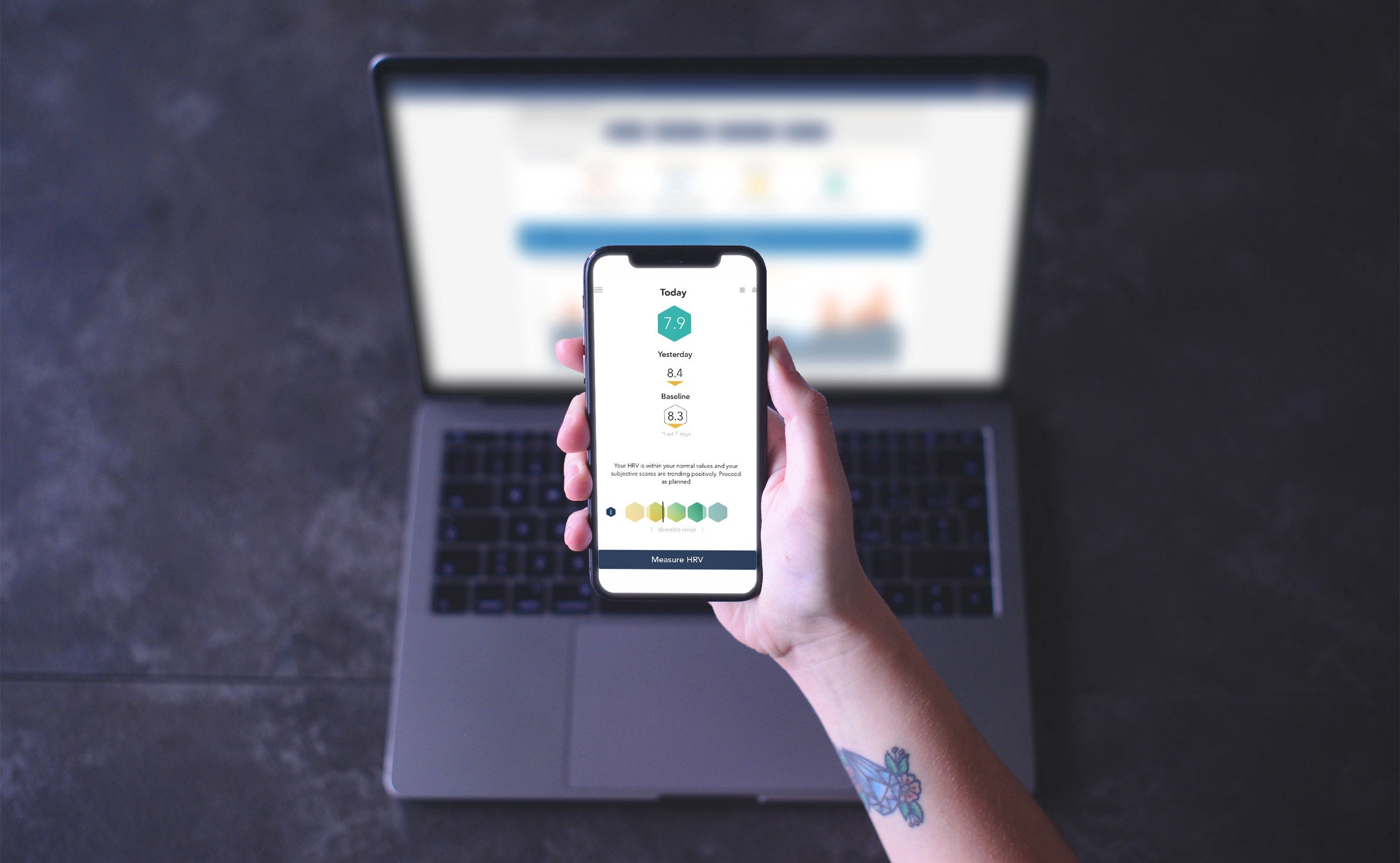 New to HRV4Training?
New to HRV4Training?

